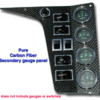I have bought this panel from PI, and I'm looking after front bumpers like they sell. So, starting to go the carbon-road, I was wondering if anyone can help me with breaking down the numbers on carbon cloth/fabric, and make me understand how to seek out some fabric I can use to make my own parts that will have the correct weave and so on so the parts will match the part I have. Will not be able to autoclave it, just use carbon instead of fiberglass.
Or just tell me exactly wich one I need from eBay: http://shop.ebay.com/?_from=R4...t=See-All-Categories
Attachments
Original Post













